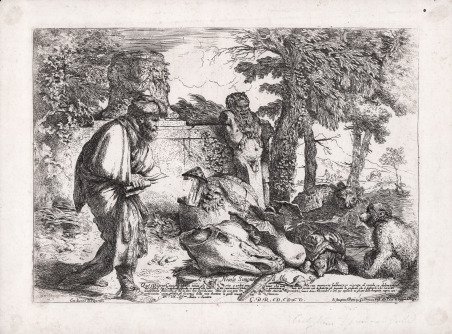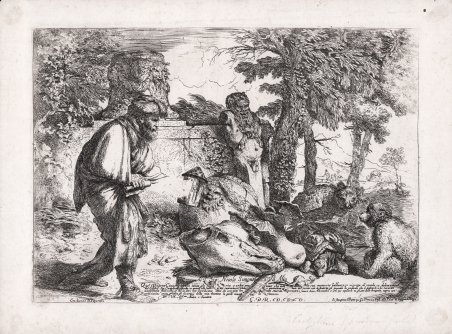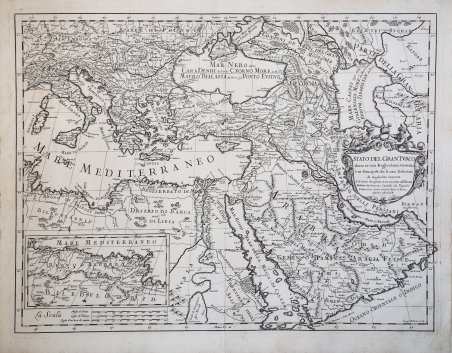Diogene alla ricerca dell'uomo onesto, 1645-1647 acquaforte, firmata in lastra in basso a sinistra G. Beneds. Castiglionus in P. Iscrizione in basso a destra: Si stampano in Roma per Gio. Domenico Rossi alla Pace e al Insegna d Parigi. Esemplare nel secondo stato di due, con al centro, la dedica a Nicolò Simonelli Mantova. In un paesaggio pieno di luce, Diogene di Sinope è rappresentato con una lanterna accesa in mano, il cui bagliore "divora" l’avambraccio. L'assenza di questo dettaglio è stata interpretata da molti studiosi come l’indizio di un’incompletezza della lastra, ma, in realtà, può essere letta come una precisa volontà dell'artista, quale aveva voluto mettere in enfasi l'intensità della luce come simbolo della verità. Sullo sfondo si apre un bosco in cui si trovano elementi che rimandano alla civiltà antica ma anche alla sua decadenza. Tra i reperti si vedono infatti un'ara scolpita a rappresentare la religione pagana, una stele raffigurante Priapo, simbolo della sessualità maschile, un otre che allude invece al mondo femminile e un cranio di cavallo, riferimento alla morte, quale fine di una vita illusoria. Questi oggetti sono immersi nella vegetazione e la natura sembra aver preso il sopravvento su di essi. La scena è, inoltre, arricchita dalla presenza di alcuni animali vivi, simboli della vanitas e degli aspetti negativi dell'uomo. Secondo l'Iconologia di Cesare Ripa, il gufo, che è un rapace notturno, rappresenta la superstizione, la scimmia l'imitazione dei caratteri peggiori dell'uomo e la tartaruga l'accidia. Sullo sfondo si osserva invece un paesaggio pastorale. La figura di Diogene rimanda al concetto filosofico della ricerca dell'uomo onesto e pieno di virtù, in allusione alle qualità del personaggio cui è stata dedicata l'incisione, ovvero Nicolo Simonelli. Quest'ultimo fu guardarobiere della famiglia Pamphili e si contraddistinse come ricercato collezionista, oltre che come appassionato di filosofia. Tra gli artisti da lui favoriti si possono ricordare Gian Lorenzo Bemini, Salvator Rosa, Pietro Testa e Pier Francesco Mola. Per sostenere la sua passione collezionistica, indirizzata in particolar modo verso i disegni, egli si dedicò inoltre al commercio di opere d'arte. La dedica, che compare soltanto nel secondo stato, è stata aggiunta dallo stampatore Giovanni Domenico Rossi. L'acquaforte riprende un disegno conservato nelle collezioni del castello di Windsor (inv, 4030; Blunt 1954, p. 38, fig. 18) e fu eseguita negli anni 1645-1647 a Genova, come si deduce dalla mancanza dell'appellativo "genuensis" che compare invece nelle lastre incise dal Grechetto fuori dalla propria città di origine. Questa invenzione ispirò Salvator Rosa nel dipinto Democrite in meditazione (Copenaghen. Statens Museurn for Kunst). Nelle sue incisioni Grechetto subì l'influenza di Rembrandt, le cui stampe iniziarono a circolare in Italia negli anni precedenti l'esecuzione del Diogene. Dal maestro olandese, il pittore originario di Genova riprende l'uso del chiaroscuro e la predilezione per effetti luministici di grande impatto visivo. La sua attività come incisore fu molto intensa: nel corso della propria carriera l'artista ideò infatti oltre sessanta composizioni da tradurre sulla lastra, prediligendo un tratto fluido e pulsante, al fine di creare risultati di grande pittoricismo. Bellissima prova, impressa su carta vergata coeva priva di filigrana, con margini, in ottimo stato di conservazione. Bibliografia Bartsch / Le Peintre graveur (XXI.20.21); Bellini 1982 / L'Opera incisa di Giovanni Benedetto Castiglione (16.II). Diogenes in Search of an Honest Man, 1645-1647 etching, signed in plate lower left G. Beneds. Castiglionus in P. Inscription in lower right: Si stampano in Roma per Gio. Domenico Rossi alla Pace e al Insegna d Parigi. Example in the second state of two, with the dedication to Nicolò Simonelli Mantova in the centre. In a landscape full of light, Diogenes of Sinope is represented with a lit lantern in his hand, the glow of which 'devours' his forearm. The absence of this detail has been interpreted by many scholars as an indication of incompleteness of the plate, but, in reality, it can be read as a precise intention of the artist, who had wanted to emphasise the intensity of the light as a symbol of truth. In the background is a forest in which there are elements reminiscent of ancient civilisation but also of its decadence. The exhibits include a carved altar representing pagan religion, a stele depicting Priapus, a symbol of male sexuality, a wineskin alluding instead to the female world, and a horse skull, a reference to death as the end of an illusory life. These objects are surrounded by vegetation and nature seems to have taken over from them. The scene is also enriched by the presence of some living animals, symbols of vanitas and the negative aspects of man. According to Cesare Ripa's Iconology, the owl, which is a nocturnal bird of prey, represents superstition, the monkey the imitation of the worst traits of man and the turtle sloth. In the background is a pastoral landscape. The figure of Diogenes refers to the philosophical concept of the search for the honest man full of virtue, in allusion to the qualities of the character to whom the engraving is dedicated, namely Nicolo Simonelli. The latter was an attendant of the Pamphili family and distinguished himself as a sought-after collector, as well as a lover of philosophy. Among his favourite artists were Gian Lorenzo Bemini, Salvator Rosa, Pietro Testa and Pier Francesco Mola. To support his collecting passion, which was particularly directed towards drawings, he also engaged in the art trade. The dedication, which only appears in the second state, was added by the printer Giovanni Domenico De Rossi. The etching is based on a drawing in the Windsor Castle collections and was executed in the years 1645-1647 in Genoa, as can be deduced from the absence of the appellation 'genuensis', which appears instead in plates engraved by Grechetto outside his home town. This invention inspired Salvator Rosa in the painting Democrite in meditation (Copenaghen. Statens Museurn for Kunst). In his engravings, Grechetto was influenced by Rembrandt, whose prints began circulating in Italy in the years before Diogenes was executed. From the Dutch master, the painter from Genoa borrowed the use of chiaroscuro and his predilection for striking luministic effects. His activity as an engraver was very intense: during his career, the artist devised more than sixty compositions to be translated onto the plate, favouring a fluid and pulsating stroke in order to create highly pictorial results. Beautiful proof, printed on contemporary laid paper without watermark, with margins, in excellent condition. Bibliografia Bartsch / Le Peintre graveur (XXI.20.21); Bellini 1982 / L'Opera incisa di Giovanni Benedetto Castiglione (16.II). Cfr.



Scopri come utilizzare
Scopri come utilizzare

